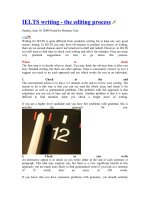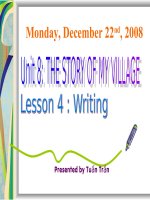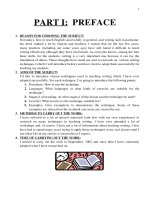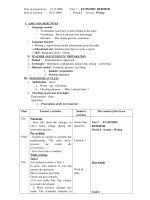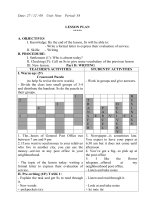tenses writing creative writing tasks
Bạn đang xem bản rút gọn của tài liệu. Xem và tải ngay bản đầy đủ của tài liệu tại đây (1.45 MB, 18 trang )
16 TENSES IN
ENGLISH
BE DONE BY; LENA MAFALDA
SIMPLE PRESENT TENSE
Generally, we use present tense to describe the present
activities or to talk about routines or habits,
Facts, generalizations and universal truths, Schedule (
Habits and routines, timetables, official meetings),
Permanent situation, Events that are certain to happen,
State verbs (e.g. be, have, suppose, know) and
Narrations, instructions or commentaries.
SENTENCE PATTERN
Declarative/Positive (+)
: S + V1 (s/es) + O + Adverb of time/place
Negative (-)
: S + DO/DOES NOT + V1 + O + Adverb of time/place
Questions/interrogative
: DO/DOES + S + V1 + O + Adverb of time/place?
Short answer (+)
: Yes, S + Do/does
Short answer (-)
: No, S + Do/does + not
NOTES;
For the subject personal pronoun; I, You, He, They: DO and He/she/It:
DOES.
When the subjects are: I, You, We and They, we don’t need to add ‘S/ES’
to the end of the verbs.
However to form the verb infinitive (V1) + S/Es) for the third singular
personal pronouns (He, She, It), here are the ways:
Generally, the verbs in present tense we add with ‘S’
Work – works
read –reads
Begin – begins
Makes – makes
sing – sings
write – writes
Become – becomes
Look –looks
shine – shines
help – helps
Walk –walks
Keep – keeps
speak – speaks
eat – eats
Sleep – sleeps
Mean – means
set –sets
Sit – sits
Visit – visits
Meet – meets
The verbs which ending with the letter “ch, o, s, sh, x, z” add with
“-es”
pass – passes
go – goes
Watch –
watches
Match – matches
teach – teaches
finish – finishes
Touch – Touches
Miss – misses
reach – reaches
wish –wishes
Relax – relaxes
Catch – catches
fix – fixes
discuss – discusses
Wash – washes
Fish – fishes
do – does
kiss – kisses
Puss – pusses
Express –
expresses
The verbs which ending with the letter “-y” and begin with
a consonant, we change “-y” to “-i” and then add with “-es”.
study –studies
worry – worries
Dry – dries
Fry – fries
carry – carries
Vary – varies
reply – replies
fly – flies
Identify – identifies cry – cries
The verbs which ending with the letter “-y” and begin with a
vowel, we just add with ‘S’ to the end of the verbs.
lay – lays
Enjoy –
enjoys
play –
plays
Destroy –
destroys
buy – buys
Slay – slays
say –says
Pay – pays
If the verbs in simple present begin with the modal
verbs, we don’t need to add with ‘S/ES’.
can
open
must
work
Must must
go
close
can read
The Present Simple is often used
with the frequency adverbs:
Always
Nowadays
From time to
time
Frequently/o Never
ften
Every now and
then
Usually
Regularly
Every week/year
Seldom/rarel Sometimes/occasionally
y
Often
EXAMPLE
1. Declarative/Positive (+) : I eat corn every Monday.
Negative (-) : I do not (don’t) eat corn every Monday.
Questions/interrogative : Do I eat corn every Monday?
Short answer (+)
: Yes, you do
//
Short answer (-)
: No, you do not (don’t)
2. Declarative/Positive (+) : You eat corn every Monday.
Negative (-) : You do not (don’t) eat corn every Monday.
Questions/interrogative : Do you eat corn every Monday?
Short answer (+) : Yes, I do. //
Short answer (-)
: No, I do not (don’t).
SIMPLE PRESENT CONTINUOUS
TENSE
There are two main uses for the present
continuous tense. It is used: to talk about ideas
that are happening at the moment of speaking
(in the present) and to express a future
arrangement between people. It usually refers
to the near Future.
SENTENCE PATTERN
Declarative/Positive (+)
: S + AM/IS/ARE +Ving + O + Adverb of time/place
Negative (-)
Questions/interrogative
: S + AM/IS/ARE + NOT + Ving + O + Ad. of time/place
: AM/IS/ARE + S + Ving + O + Ad. of time/place?
Short answer (+)
: Yes, S + AM/IS/ARE
Short answer (-)
: No, S + AM/IS/ARE/ not
NOTE;
The way to use auxiliary verb (AM/IS/ARE):
Subject; I = Am
You/we/they = Are
He/She/It = Is
The way to form the verb in present participle or V1+ing
1. If the word ends in –e, drop the –e and add –ing.
Ex; hope = hoping, date = dating, injure = injuring, etc
2. Verbs that end in a vowel and a consonant, add the ending letter (double), and add
–ing.
One syllable:
Ex; stop = stopping, beg = begging, rob = robbing, etc. (1 vowel = 2 consonants)
Ex; rain = raining, fool = fooling, dream = dreaming, etc. (2 vowel = 1 consonants)
Two syllable:
Ex; listen = listening, open = opening, etc. (1 st syllable stressed)
Ex; begin = beginning, control = controlling, etc (2 nd syllable stressed)
3. Verbs that end in two consonants, just add the –ing to the ending
Ex; start = starting, fold = folding, demand = demanding, etc
4. Verbs that end –y, if –y preceded by a vowel/consonant, keep the –y
Ex; enjoy = enjoying, buy = buying, pray = praying, studying, trying,
replying, etc
5. Verbs that end in –ie, change –ie to –y and add with –ing
Ex; die = dying, lie = lying, tie = tying, etc.
Time expressions:
At the time of speaking
Now
At the
Future actions
This afternoon In numbers
(days)
In numbers
Tomorrow
moment
At this time
(weeks)
Later
In numbers
(months)
EXAMPLE
1. Declarative/Positive (+) : We are studying English grammar at the moment.
Negative (-) : We are not studying English grammar at the moment.
Questions/interrogative
: Are we studying English grammar at the moment?
Short answer (+) : Yes, we are.
//
Short answer (-) : No, we are not (aren’t)
2. Declarative/Positive (+) : Valeria is visiting her cousins this weekend.
Negative (-)
: Valeria is not visiting her cousins this weekend.
Questions/interrogative
: Is Valeria visiting her cousins this weekend?
Short answer (+) : Yes, she is.
//
Short answer (-)
: No, she is not (isn’t)


